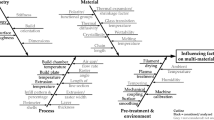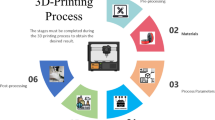Abstract
The impact of 3D printing and how it is present in everyday life is unquestionable. Provided with almost total freedom of design and a vast list of materials, 3D printing has attracted enormous interest, being the fused filament fabrication (FFF) technique one of the main drivers. Given the vast range of compatible materials, FFF potential is being further developed towards multi-material prints. Still, one of the main challenges in such multi-material print is to predict the affinity between different materials in advance. This paper explores an expedited method to evaluate if two different materials can work together. The method is based on polymer joining using a hot plate welding process. Different filament materials welded together are compared with hybrid parts printed by FFF with the same filaments. The results are benchmarked to find out if the performance under welding follows the same pattern as in 3D multi-material printing. Therefore, the present study encompasses different combinations of rigid (Polycarbonate, PC, and Polyamide, PA) and flexible (thermoplastic elastomers, NinjaFlex, FilaFlex, and TPC 45) materials and also pairs of each one of these materials. The results showed that there is a loss of performance of the single material welded or multi-material printed samples when compared to their corresponding monolithic counterparts. Moreover, the results also showed a similar performance profile for multi-material samples obtained through welding and 3D printing. The technique here proposed proved to be an expedited method to assess material’s relative affinity, a critical feature to guarantee their adequacy for use in FFF multi-material printing.










Similar content being viewed by others
References
Emon MOF, Alkadi F, Philip DG et al (2019) Multi-material 3D printing of a soft pressure sensor. Addit Manuf 28:629–638. https://doi.org/10.1016/j.addma.2019.06.001
Rafiee M, Farahani RD, Therriault D (2020) Multi-material 3D and 4D printing: a survey. Adv Sci. https://doi.org/10.1002/advs.201902307
Goh GL, Zhang H, Chong TH, Yeong WY (2021) 3D printing of multilayered and multimaterial electronics: a review. Adv Electronic Mater. https://doi.org/10.1002/aelm.202100445
Carneiro OS, Silva AF, Gomes R (2015) Fused deposition modeling with polypropylene. Mater Des 83:768–776. https://doi.org/10.1016/j.matdes.2015.06.053
Costa AE, Ferreira da Silva A, Sousa Carneiro O (2019) A study on extruded filament bonding in fused filament fabrication. Rapid Prototyping J 25:555–565. https://doi.org/10.1108/RPJ-03-2018-0062
Cuan-Urquizo E, Barocio E, Tejada-Ortigoza V et al (2019) Characterization of the mechanical properties of FFF structures and materials: a review on the experimental, computational and theoretical approaches. Materials 12:895. https://doi.org/10.3390/ma12060895
Khaliq MH, Gomes R, Fernandes C et al (2017) On the use of high viscosity polymers in the fused filament fabrication process. Rapid Prototyping J 23:727–735. https://doi.org/10.1108/RPJ-02-2016-0027
Shih C-C, Burnette M, Staack D et al (2019) Effects of cold plasma treatment on interlayer bonding strength in FFF process. Addit Manuf 25:104–111. https://doi.org/10.1016/j.addma.2018.11.005
Lopes LR, Silva AF, Carneiro OS (2018) Multi-material 3D printing: The relevance of materials affinity on the boundary interface performance. Addit Manuf 23:45–52. https://doi.org/10.1016/j.addma.2018.06.027
Ribeiro M, Sousa Carneiro O, Ferreira da Silva A (2019) Interface geometries in 3D multi-material prints by fused filament fabrication. Rapid Prototyping J 25:38–46. https://doi.org/10.1108/RPJ-05-2017-0107
Kluczyński J, Śniezek L, Kravcov A et al (2020) The examination of restrained joints created in the process of multi-material FFF additive manufacturing technology. Materials. https://doi.org/10.3390/ma13040903
Grewell D, Benatar A (2007) Welding of plastics: fundamentals and new developments. Int Polym Proc 22:43–60. https://doi.org/10.3139/217.0051
Malguarnera SC, Manisali AI, Riggs DC (1981) Weld line structures and properties in injection molded polypropylene. Polym Eng Sci 21:1149–1155. https://doi.org/10.1002/pen.760211706
Ferrás LL, Sitotaw Y, Fernandes C et al (2018) A numerical and experimental study on weld lines formation and strength in extrusion. Polym Eng Sci 58:249–260. https://doi.org/10.1002/pen.24551
Carneiro OS, Oliveira MJ, Martins RL (2007) Effect of pinch-off welding on quality of food packaging bottle. Plast, Rubber Compos 36:173–178. https://doi.org/10.1179/174328907X191387
Sun Q, Rizvi GM, Bellehumeur CT, Gu P (2008) Effect of processing conditions on the bonding quality of FDM polymer filaments. Rapid Prototyping J 14:72–80. https://doi.org/10.1108/13552540810862028
Bellehumeur C, Li L, Sun Q, Gu P (2004) Modeling of bond formation between polymer filaments in the fused deposition modeling process. J Manuf Process 6:170–178. https://doi.org/10.1016/S1526-6125(04)70071-7
Costa SF, Duarte FM, Covas JA (2015) Thermal conditions affecting heat transfer in FDM/FFE: a contribution towards the numerical modelling of the process. Virtual Phys Prototyping 10:35–46. https://doi.org/10.1080/17452759.2014.984042
Oliveira MJ, Bernardo CA, Hemsley DA (2001) Morphology and mechanical behavior of polypropylene hot plate welds. Polym Eng Sci 41:1913–1922. https://doi.org/10.1002/pen.10888
Oliveira MJ, Bernardo CA, Hemsley DA (2002) The effect of flame retardants on the hot-plate welding of talc-filled polypropylene. Polym Eng Sci 42:146–151. https://doi.org/10.1002/pen.10935
Quelho de Macedo R, Ferreira RTL, Jayachandran K (2019) Determination of mechanical properties of FFF 3D printed material by assessing void volume fraction, cooling rate and residual thermal stresses. Rapid Prototyping J 25:1661–1683. https://doi.org/10.1108/RPJ-08-2018-0192
Funding
This work was supported by FEDER funds through the COMPETE 2020 program and National Funds through Fundação para a Ciência e a Tecnologia (FCT) to IPC under projects UIDB/05256/2020 (IPC), UIDP/05256/2020 (IPC), UIDB/04436/2020 (CMEMS) and UIDP/04436/2020 (CMEMS).
Author information
Authors and Affiliations
Corresponding author
Additional information
Publisher's Note
Springer Nature remains neutral with regard to jurisdictional claims in published maps and institutional affiliations.
Rights and permissions
About this article
Cite this article
Cunha, P., Teixeira, R., Carneiro, O.S. et al. Multi-material fused filament fabrication: an expedited methodology to assess the affinity between different materials. Prog Addit Manuf 8, 195–204 (2023). https://doi.org/10.1007/s40964-022-00322-6
Received:
Accepted:
Published:
Issue Date:
DOI: https://doi.org/10.1007/s40964-022-00322-6




